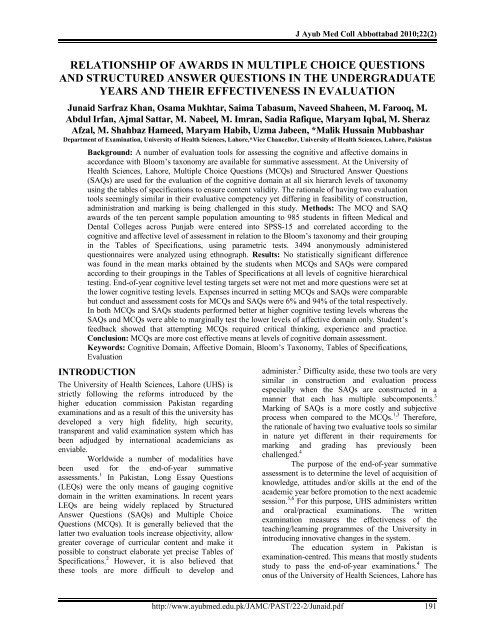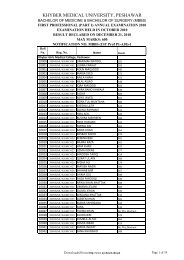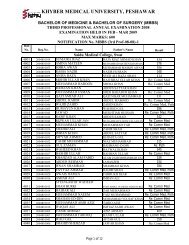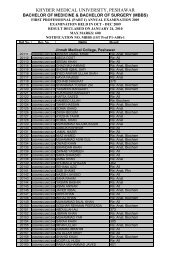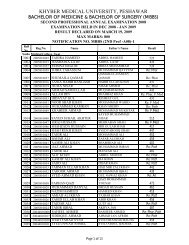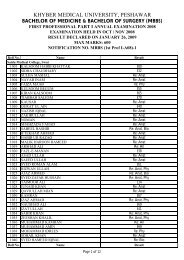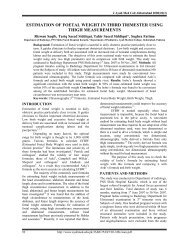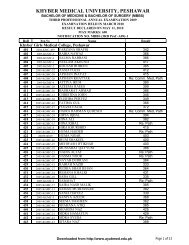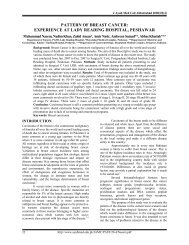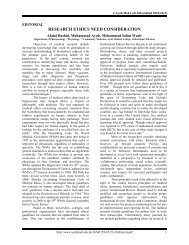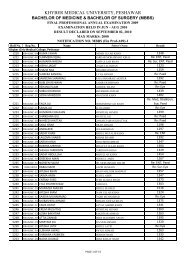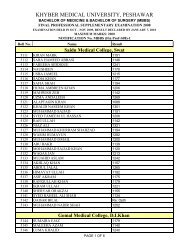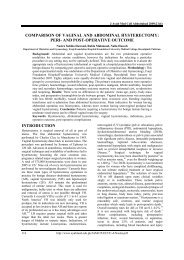relationship of awards in multiple choice questions and structured ...
relationship of awards in multiple choice questions and structured ...
relationship of awards in multiple choice questions and structured ...
You also want an ePaper? Increase the reach of your titles
YUMPU automatically turns print PDFs into web optimized ePapers that Google loves.
J Ayub Med Coll Abbottabad 2010;22(2)<br />
RELATIONSHIP OF AWARDS IN MULTIPLE CHOICE QUESTIONS<br />
AND STRUCTURED ANSWER QUESTIONS IN THE UNDERGRADUATE<br />
YEARS AND THEIR EFFECTIVENESS IN EVALUATION<br />
Junaid Sarfraz Khan, Osama Mukhtar, Saima Tabasum, Naveed Shaheen, M. Farooq, M.<br />
Abdul Irfan, Ajmal Sattar, M. Nabeel, M. Imran, Sadia Rafique, Maryam Iqbal, M. Sheraz<br />
Afzal, M. Shahbaz Hameed, Maryam Habib, Uzma Jabeen, *Malik Hussa<strong>in</strong> Mubbashar<br />
Department <strong>of</strong> Exam<strong>in</strong>ation, University <strong>of</strong> Health Sciences, Lahore,*Vice Chancellor, University <strong>of</strong> Health Sciences, Lahore, Pakistan<br />
Background: A number <strong>of</strong> evaluation tools for assess<strong>in</strong>g the cognitive <strong>and</strong> affective doma<strong>in</strong>s <strong>in</strong><br />
accordance with Bloom’s taxonomy are available for summative assessment. At the University <strong>of</strong><br />
Health Sciences, Lahore, Multiple Choice Questions (MCQs) <strong>and</strong> Structured Answer Questions<br />
(SAQs) are used for the evaluation <strong>of</strong> the cognitive doma<strong>in</strong> at all six hierarch levels <strong>of</strong> taxonomy<br />
us<strong>in</strong>g the tables <strong>of</strong> specifications to ensure content validity. The rationale <strong>of</strong> hav<strong>in</strong>g two evaluation<br />
tools seem<strong>in</strong>gly similar <strong>in</strong> their evaluative competency yet differ<strong>in</strong>g <strong>in</strong> feasibility <strong>of</strong> construction,<br />
adm<strong>in</strong>istration <strong>and</strong> mark<strong>in</strong>g is be<strong>in</strong>g challenged <strong>in</strong> this study. Methods: The MCQ <strong>and</strong> SAQ<br />
<strong>awards</strong> <strong>of</strong> the ten percent sample population amount<strong>in</strong>g to 985 students <strong>in</strong> fifteen Medical <strong>and</strong><br />
Dental Colleges across Punjab were entered <strong>in</strong>to SPSS-15 <strong>and</strong> correlated accord<strong>in</strong>g to the<br />
cognitive <strong>and</strong> affective level <strong>of</strong> assessment <strong>in</strong> relation to the Bloom’s taxonomy <strong>and</strong> their group<strong>in</strong>g<br />
<strong>in</strong> the Tables <strong>of</strong> Specifications, us<strong>in</strong>g parametric tests. 3494 anonymously adm<strong>in</strong>istered<br />
questionnaires were analyzed us<strong>in</strong>g ethnograph. Results: No statistically significant difference<br />
was found <strong>in</strong> the mean marks obta<strong>in</strong>ed by the students when MCQs <strong>and</strong> SAQs were compared<br />
accord<strong>in</strong>g to their group<strong>in</strong>gs <strong>in</strong> the Tables <strong>of</strong> Specifications at all levels <strong>of</strong> cognitive hierarchical<br />
test<strong>in</strong>g. End-<strong>of</strong>-year cognitive level test<strong>in</strong>g targets set were not met <strong>and</strong> more <strong>questions</strong> were set at<br />
the lower cognitive test<strong>in</strong>g levels. Expenses <strong>in</strong>curred <strong>in</strong> sett<strong>in</strong>g MCQs <strong>and</strong> SAQs were comparable<br />
but conduct <strong>and</strong> assessment costs for MCQs <strong>and</strong> SAQs were 6% <strong>and</strong> 94% <strong>of</strong> the total respectively.<br />
In both MCQs <strong>and</strong> SAQs students performed better at higher cognitive test<strong>in</strong>g levels whereas the<br />
SAQs <strong>and</strong> MCQs were able to marg<strong>in</strong>ally test the lower levels <strong>of</strong> affective doma<strong>in</strong> only. Student’s<br />
feedback showed that attempt<strong>in</strong>g MCQs required critical th<strong>in</strong>k<strong>in</strong>g, experience <strong>and</strong> practice.<br />
Conclusion: MCQs are more cost effective means at levels <strong>of</strong> cognitive doma<strong>in</strong> assessment.<br />
Keywords: Cognitive Doma<strong>in</strong>, Affective Doma<strong>in</strong>, Bloom’s Taxonomy, Tables <strong>of</strong> Specifications,<br />
Evaluation<br />
INTRODUCTION<br />
The University <strong>of</strong> Health Sciences, Lahore (UHS) is<br />
strictly follow<strong>in</strong>g the reforms <strong>in</strong>troduced by the<br />
higher education commission Pakistan regard<strong>in</strong>g<br />
exam<strong>in</strong>ations <strong>and</strong> as a result <strong>of</strong> this the university has<br />
developed a very high fidelity, high security,<br />
transparent <strong>and</strong> valid exam<strong>in</strong>ation system which has<br />
been adjudged by <strong>in</strong>ternational academicians as<br />
enviable.<br />
Worldwide a number <strong>of</strong> modalities have<br />
been used for the end-<strong>of</strong>-year summative<br />
assessments. 1 In Pakistan, Long Essay Questions<br />
(LEQs) were the only means <strong>of</strong> gaug<strong>in</strong>g cognitive<br />
doma<strong>in</strong> <strong>in</strong> the written exam<strong>in</strong>ations. In recent years<br />
LEQs are be<strong>in</strong>g widely replaced by Structured<br />
Answer Questions (SAQs) <strong>and</strong> Multiple Choice<br />
Questions (MCQs). It is generally believed that the<br />
latter two evaluation tools <strong>in</strong>crease objectivity, allow<br />
greater coverage <strong>of</strong> curricular content <strong>and</strong> make it<br />
possible to construct elaborate yet precise Tables <strong>of</strong><br />
Specifications. 2 However, it is also believed that<br />
these tools are more difficult to develop <strong>and</strong><br />
adm<strong>in</strong>ister. 2 Difficulty aside, these two tools are very<br />
similar <strong>in</strong> construction <strong>and</strong> evaluation process<br />
especially when the SAQs are constructed <strong>in</strong> a<br />
manner that each has <strong>multiple</strong> subcomponents. 3<br />
Mark<strong>in</strong>g <strong>of</strong> SAQs is a more costly <strong>and</strong> subjective<br />
process when compared to the MCQs. 1,3 Therefore,<br />
the rationale <strong>of</strong> hav<strong>in</strong>g two evaluative tools so similar<br />
<strong>in</strong> nature yet different <strong>in</strong> their requirements for<br />
mark<strong>in</strong>g <strong>and</strong> grad<strong>in</strong>g has previously been<br />
challenged. 4<br />
The purpose <strong>of</strong> the end-<strong>of</strong>-year summative<br />
assessment is to determ<strong>in</strong>e the level <strong>of</strong> acquisition <strong>of</strong><br />
knowledge, attitudes <strong>and</strong>/or skills at the end <strong>of</strong> the<br />
academic year before promotion to the next academic<br />
session. 5,6 For this purpose, UHS adm<strong>in</strong>isters written<br />
<strong>and</strong> oral/practical exam<strong>in</strong>ations. The written<br />
exam<strong>in</strong>ation measures the effectiveness <strong>of</strong> the<br />
teach<strong>in</strong>g/learn<strong>in</strong>g programmes <strong>of</strong> the University <strong>in</strong><br />
<strong>in</strong>troduc<strong>in</strong>g <strong>in</strong>novative changes <strong>in</strong> the system.<br />
The education system <strong>in</strong> Pakistan is<br />
exam<strong>in</strong>ation-centred. This means that mostly students<br />
study to pass the end-<strong>of</strong>-year exam<strong>in</strong>ations. 4 The<br />
onus <strong>of</strong> the University <strong>of</strong> Health Sciences, Lahore has<br />
http://www.ayubmed.edu.pk/JAMC/PAST/22-2/Junaid.pdf 191
J Ayub Med Coll Abbottabad 2010;22(2)<br />
always been on encourag<strong>in</strong>g students to ga<strong>in</strong><br />
knowledge, change attitudes <strong>and</strong> atta<strong>in</strong> psychomotor<br />
skills necessary to become competent <strong>and</strong> safe<br />
pr<strong>of</strong>essionals. To that end the University has<br />
developed Tables <strong>of</strong> Specifications, detail<strong>in</strong>g the<br />
necessary levels <strong>of</strong> competency <strong>in</strong> all areas, <strong>in</strong> each<br />
subject. These Tables provide details <strong>of</strong> level <strong>of</strong><br />
competency <strong>in</strong> each area related to Bloom’s<br />
Taxonomy <strong>and</strong> their relative importance with<strong>in</strong> the<br />
subject <strong>and</strong> to the student. Therefore, there might be<br />
topics that require assessment <strong>of</strong> factual knowledge<br />
yet with<strong>in</strong> the same subject there might be topics that<br />
require analysis/comprehension <strong>and</strong>/or synthesis or<br />
assessment <strong>of</strong> changes <strong>in</strong> attitudes <strong>and</strong> acquisition <strong>of</strong><br />
certa<strong>in</strong> psychomotor skills. The rationale, is to tailor<br />
the learn<strong>in</strong>g <strong>and</strong> evaluation <strong>of</strong> students to the needs <strong>of</strong><br />
the local, regional <strong>and</strong> <strong>in</strong>ternational population <strong>and</strong><br />
dem<strong>and</strong>s. 7,8<br />
Written exam<strong>in</strong>ations measur<strong>in</strong>g knowledge<br />
<strong>and</strong> attitudes <strong>of</strong> students learnt over the previous year<br />
can be constructed us<strong>in</strong>g a number <strong>of</strong> assessment<br />
tools. 1,9 The three most commonly used tools by<br />
Universities <strong>in</strong> Pakistan are the Long Essay<br />
Questions (LEQ), the Structured Answer Questions<br />
(SAQ) <strong>and</strong> the Multiple Choice Questions (MCQ).<br />
University <strong>of</strong> Health Sciences now uses SAQs <strong>and</strong><br />
MCQs <strong>in</strong> all Bachelor <strong>of</strong> Medic<strong>in</strong>e; Bachelor <strong>of</strong><br />
Surgery (MBBS) <strong>and</strong> Bachelor <strong>of</strong> Dental Surgery<br />
(BDS) Pr<strong>of</strong>essional exam<strong>in</strong>ations. Before the<br />
University shifts emphasis from LEQs to objective<br />
tools <strong>of</strong> evaluation such as MCQs <strong>and</strong> SAQs <strong>in</strong> the<br />
postgraduate exam<strong>in</strong>ations as well, further research is<br />
warranted <strong>in</strong> determ<strong>in</strong><strong>in</strong>g the most effective <strong>and</strong> costeffective<br />
evaluation modality <strong>in</strong> assess<strong>in</strong>g the<br />
knowledge <strong>and</strong> attitudes keep<strong>in</strong>g Bloom’s Taxonomy<br />
as a guide.<br />
The research project is aimed at determ<strong>in</strong><strong>in</strong>g<br />
the <strong>relationship</strong> <strong>of</strong> <strong>awards</strong> obta<strong>in</strong>ed by students <strong>in</strong><br />
these two components <strong>and</strong> also the effectiveness <strong>of</strong><br />
these methods as an evaluation tool <strong>in</strong> measur<strong>in</strong>g<br />
cognitive <strong>and</strong> affective skills, two <strong>of</strong> the three<br />
components <strong>of</strong> Bloom’s Taxonomy.<br />
It is believed that MCQs <strong>and</strong> SAQS though<br />
different <strong>in</strong> construction <strong>and</strong> nature, measure the<br />
same entities quite similarly. 10 Whereas MCQs are<br />
entirely objective <strong>and</strong> can be evaluated us<strong>in</strong>g Optical<br />
Mark Reader Technology, SAQs require tedious<br />
manual ‘subjective’ assessment. 11<br />
The study will also provide an opportunity:<br />
1. To determ<strong>in</strong>e the Affective <strong>and</strong> Cognitive level<br />
<strong>of</strong> each MCQ <strong>and</strong> SAQ constructed for Annual<br />
2008 <strong>and</strong> 2009 exam<strong>in</strong>ations.<br />
2. The response <strong>of</strong> students <strong>in</strong> relation to the level<br />
<strong>and</strong> difficulty <strong>in</strong>dex (DI) <strong>of</strong> each question.<br />
3. The acceptability level <strong>of</strong> MCQ <strong>and</strong>/or SAQ<br />
components <strong>of</strong> theory exam<strong>in</strong>ation amongst the<br />
student population.<br />
4. To propose changes <strong>in</strong> the evaluation process<br />
based on the f<strong>in</strong>d<strong>in</strong>gs <strong>of</strong> the study.<br />
There is no evidence <strong>of</strong> similar research at National<br />
level to date.<br />
The objectives <strong>of</strong> study were:<br />
1. To determ<strong>in</strong>e the correlation between the MCQ<br />
<strong>and</strong> SAQ component based on the Table <strong>of</strong><br />
Specifications <strong>and</strong> Bloom’s Taxonomy.<br />
2. To determ<strong>in</strong>e the most cost-effective means <strong>of</strong><br />
evaluation<br />
3. To determ<strong>in</strong>e the effectiveness <strong>of</strong> the end-<strong>of</strong>-year<br />
evaluation process <strong>in</strong> relation to the Bloom’s<br />
Taxonomy.<br />
4. To evaluate the response <strong>of</strong> students <strong>in</strong> relation<br />
to the level <strong>and</strong> DI <strong>of</strong> each question.<br />
5. To determ<strong>in</strong>e the Affective <strong>and</strong> Cognitive level<br />
<strong>of</strong> each MCQ <strong>and</strong> SAQ measured <strong>in</strong> Annual<br />
2008 <strong>and</strong> 2009 exam<strong>in</strong>ations.<br />
6. To ga<strong>in</strong> student’s perspective on the current<br />
system <strong>of</strong> evaluation <strong>and</strong> correlate it with the<br />
results <strong>of</strong> this study.<br />
7. To identify areas requir<strong>in</strong>g improvement <strong>in</strong> the<br />
current evaluation techniques <strong>and</strong> suggest<br />
solutions.<br />
MATERIAL AND METHODS<br />
The study was based on the results <strong>in</strong> the MCQ <strong>and</strong><br />
SAQ components <strong>of</strong> written exam<strong>in</strong>ations <strong>in</strong> all<br />
Pr<strong>of</strong>essional Annual 2008 <strong>and</strong> 2009 MBBS <strong>and</strong> BDS<br />
exam<strong>in</strong>ations. The MCQ <strong>and</strong> SAQ papers<br />
adm<strong>in</strong>istered to students were analysed <strong>and</strong><br />
compartmentalised <strong>in</strong> relation to the Tables <strong>of</strong><br />
Specifications. Respective <strong>awards</strong> <strong>of</strong> each student <strong>in</strong><br />
each subject <strong>of</strong> every Pr<strong>of</strong>essional exam<strong>in</strong>ation were<br />
entered <strong>in</strong>to SPSS v. 15 <strong>and</strong> analyzed us<strong>in</strong>g Student’s<br />
t-test. 12 The analysis <strong>in</strong>cluded correlation <strong>of</strong> <strong>awards</strong><br />
for each component <strong>of</strong> the Table <strong>of</strong> Specification <strong>in</strong><br />
each subject. Next the degree <strong>of</strong> correlation between<br />
the MCQs <strong>and</strong> SAQs for each area <strong>of</strong> the Table <strong>of</strong><br />
Specification <strong>in</strong> relation to Bloom’s Taxonomy 13 was<br />
determ<strong>in</strong>ed. For this, each MCQ or SAQ was graded<br />
depend<strong>in</strong>g on its level <strong>in</strong> the Taxonomy <strong>and</strong><br />
compared with its counterpart. Interpretation<br />
depended on the analysis <strong>and</strong> <strong>relationship</strong> <strong>of</strong> each<br />
component <strong>of</strong> the MCQ <strong>and</strong> SAQ paper <strong>in</strong> relevance<br />
to the tables <strong>of</strong> specifications <strong>and</strong> Bloom’s<br />
Taxonomy. A questionnaire to be filled anonymously<br />
was circulated to students sitt<strong>in</strong>g <strong>in</strong> these<br />
exam<strong>in</strong>ations, which was used to measure the<br />
acceptability <strong>and</strong> op<strong>in</strong>ion <strong>of</strong> students regard<strong>in</strong>g this<br />
system <strong>of</strong> exam<strong>in</strong>ations.<br />
At the time <strong>of</strong> this study, there were 15<br />
medical <strong>and</strong> dental colleges affiliated with UHS with<br />
192<br />
http://www.ayubmed.edu.pk/JAMC/PAST/22-2/Junaid.pdf
J Ayub Med Coll Abbottabad 2010;22(2)<br />
a total student population <strong>of</strong> 9,840. A total <strong>of</strong> 34,906<br />
questionnaires were received (<strong>of</strong> all pr<strong>of</strong>essional<br />
exam<strong>in</strong>ations <strong>in</strong> each <strong>of</strong> the eighteen subjects).<br />
Stratified r<strong>and</strong>om sampl<strong>in</strong>g was applied college,<br />
pr<strong>of</strong>essional exam<strong>in</strong>ations <strong>and</strong> subject wise <strong>and</strong> 10%<br />
<strong>of</strong> the total population was <strong>in</strong>cluded <strong>in</strong> the study. This<br />
meant that the sample population was 985 students.<br />
S<strong>in</strong>ce each subject is to be considered this means that<br />
a total <strong>of</strong> 3,494 questionnaires were analysed together<br />
with the <strong>in</strong>dividual <strong>awards</strong> <strong>of</strong> each SAQ <strong>and</strong> its<br />
compatible set <strong>of</strong> MCQs accord<strong>in</strong>g to the Bloom’s<br />
Taxonomy.<br />
RESULTS<br />
1. The correlation between the MCQs <strong>and</strong> SAQs<br />
component based on the Table <strong>of</strong> Specifications <strong>and</strong><br />
Bloom’s taxonomy:<br />
Paired Sample t-test was applied on a sample <strong>of</strong> 3,494<br />
<strong>and</strong> no significant difference was found <strong>in</strong> mean marks<br />
<strong>of</strong> SAQs <strong>and</strong> MCQs, (Table-1).<br />
Table-1: Results <strong>of</strong> paired sample t-test <strong>of</strong> MCQs vs<br />
SAQs<br />
t-Statistics p<br />
Table <strong>of</strong> SAQs vs MCQs based on Tables <strong>of</strong><br />
Specifications Specifications<br />
1.93 0.06<br />
Bloom’s C1. Knowledge 1.92 0.06<br />
Taxonomy C2. Comprehension 1.82 0.69<br />
C3. Application 1.68 0.94<br />
C4. Analysis 3.25 0.07<br />
C5. Synthesis 1.75 0.08<br />
C6. Evaluation 1.44 0.15<br />
2. The most cost-effective means <strong>of</strong> evaluation:<br />
Dur<strong>in</strong>g the period <strong>of</strong> the study, the total cost <strong>of</strong> sett<strong>in</strong>g,<br />
conduct<strong>in</strong>g <strong>and</strong> assess<strong>in</strong>g all MCQs <strong>and</strong> SAQs (from<br />
Paper sett<strong>in</strong>g to the f<strong>in</strong>al Paper assessment) was<br />
approximately Rs. 47 million (Cost <strong>of</strong> Paper Sett<strong>in</strong>g was<br />
approximately Rs. 0.14 million <strong>and</strong> Conduct <strong>and</strong><br />
Assessment was approximately Rs. 46.86 million).<br />
3. The effectiveness <strong>of</strong> end-<strong>of</strong>-year evaluation<br />
process <strong>in</strong> relation to Bloom’s taxonomy:<br />
Cognitive level targets set to assess the Cognitive<br />
Doma<strong>in</strong> were not met as <strong>in</strong>dicated <strong>in</strong> Table-2.<br />
Table-2: Cognitive level targets met <strong>in</strong> the end<strong>of</strong>-year<br />
Evaluation <strong>in</strong> Relation to Bloom’s<br />
Taxonomy<br />
Bloom’s<br />
Target to Set the<br />
Paper accord<strong>in</strong>g to<br />
Paper set <strong>in</strong> 2008<br />
<strong>and</strong> 2009<br />
Taxonomy Bloom’s Taxonomy MCQS SAQS<br />
C1 & C2 33–34% 45.4% 51.3%<br />
C3 & C4 33–34% 38.1% 37.2%<br />
C5 & C6 33–34% 16.5% 11.5%<br />
4. The response <strong>of</strong> students <strong>in</strong> relation to the level<br />
<strong>and</strong> difficulty <strong>in</strong>dex (DI) <strong>of</strong> each question:<br />
Students’ performed well <strong>in</strong> C5 <strong>and</strong> C6 category <strong>of</strong><br />
Bloom’s taxonomy. The results are shown <strong>in</strong> Figure-1.<br />
5. The Affective <strong>and</strong> Cognitive level <strong>of</strong> each MCQ<br />
<strong>and</strong> SAQ measured <strong>in</strong> Annual 2008 <strong>and</strong> 2009<br />
exam<strong>in</strong>ation:<br />
Total 3,514 MCQs were set dur<strong>in</strong>g the study period, <strong>of</strong><br />
which 816 (23.3%) were set at the level <strong>of</strong> C1 category<br />
<strong>of</strong> Bloom’s taxonomy <strong>and</strong> 776 (22.1%), 780 (22.2%),<br />
560 (15.9%), 300 (8.5%) <strong>and</strong> 280 (8.0%) were set at<br />
C2, C3, C4, C5 <strong>and</strong> C6 levels <strong>in</strong> the Bloom’s<br />
Taxonomy, respectively. On the other h<strong>and</strong>, 888 SAQs<br />
were set, <strong>of</strong> which 250 (28.6%) were set at the level <strong>of</strong><br />
C1 category <strong>of</strong> Bloom’s taxonomy, 206 (23.2%), 196<br />
(22.1%), 134 (15.1%), 80 (9.0%) <strong>and</strong> 22 (2.5%) were<br />
set at C2, C3, C4, C5 <strong>and</strong> C6 category <strong>of</strong> Bloom’s<br />
Taxonomy, respectively. Only 350 (10 %) MCQs were<br />
set cater<strong>in</strong>g for A1 category <strong>in</strong> the Affective doma<strong>in</strong><br />
<strong>and</strong> 173(5 %) for the A2 category. No other category<br />
<strong>of</strong> Affective doma<strong>in</strong> was covered by other <strong>questions</strong>.<br />
Similarly 10 % <strong>and</strong> 4 % SAQs were set at A1 <strong>and</strong> A2<br />
levels <strong>of</strong> Affective doma<strong>in</strong> respectively.<br />
6. Students’ perspective on the current system <strong>of</strong><br />
evaluation:<br />
Perception <strong>of</strong> the students on the current system <strong>of</strong><br />
evaluation is given <strong>in</strong> Figure-2.<br />
Figure-1: Marks obta<strong>in</strong>ed at various cognitive<br />
levels <strong>in</strong> accordance with Bloom’s Taxonomy<br />
Figure-2: Students’ perspective on the current<br />
system <strong>of</strong> evaluation<br />
DISCUSSION<br />
In the context <strong>of</strong> the present study, the Multiple<br />
Choice Questions (MCQs) <strong>and</strong> the Structured<br />
Answer Questions (SAQs) were to be compared<br />
http://www.ayubmed.edu.pk/JAMC/PAST/22-2/Junaid.pdf 193
J Ayub Med Coll Abbottabad 2010;22(2)<br />
based on the tables <strong>of</strong> specifications <strong>and</strong> the Bloom’s<br />
Taxonomy for effectiveness as a tool <strong>of</strong> evaluation<br />
<strong>in</strong>clud<strong>in</strong>g validity, reliability, cost effectiveness <strong>and</strong><br />
feasibility; <strong>and</strong> acceptability amongst exam<strong>in</strong>ers <strong>and</strong><br />
the adm<strong>in</strong>istrators. Bloom published his taxonomy <strong>of</strong><br />
cognitive learn<strong>in</strong>g based on a hierarchy <strong>of</strong><br />
knowledge, comprehension, application, analysis,<br />
synthesis <strong>and</strong> evaluation. 14 In the Pr<strong>of</strong>essional MBBS<br />
<strong>and</strong> BDS exam<strong>in</strong>ations held <strong>in</strong> 2008 <strong>and</strong> 2009 at<br />
UHS, each MCQ <strong>and</strong> SAQ <strong>in</strong> the evaluation<br />
<strong>in</strong>strument was designed to test at the same level <strong>of</strong><br />
learn<strong>in</strong>g as the objective it was designed to assess <strong>in</strong><br />
accordance to the Tables <strong>of</strong> Specifications (TOS) for<br />
any particular subject.<br />
Our result showed that students were able to<br />
score equally well <strong>in</strong> both MCQs <strong>and</strong> SAQs at all six<br />
levels <strong>of</strong> Bloom’s taxonomy. Therefore, a well<br />
constructed MCQ is just as good as an SAQ <strong>in</strong> test<strong>in</strong>g<br />
higher levels <strong>of</strong> cognitive skills. The result is not<br />
dissimilar from that <strong>of</strong> a study by Mousumi<br />
Mukhopadhyay et al. 15 In this study Mousumi<br />
Mukhopadhyay et al. justified the use <strong>of</strong> MCQs for<br />
test<strong>in</strong>g <strong>of</strong> higher cognitive skills <strong>in</strong> Medical<br />
Education. Moeen-uz-zafar <strong>and</strong> Badraljarallah 16 <strong>in</strong><br />
their study described that construct<strong>in</strong>g an SAQ was<br />
far more time <strong>and</strong> resource consum<strong>in</strong>g than an MCQ,<br />
but a well-constructed MCQ was superior to an SAQ<br />
<strong>in</strong> test<strong>in</strong>g higher cognitive skills <strong>of</strong> undergraduate<br />
medical students <strong>in</strong> a problem-based learn<strong>in</strong>g setup.<br />
Our study, therefore, has confirmed the<br />
impression that well-constructed MCQs with high<br />
construct & context validity alone can be utilized to<br />
test knowledge as well as higher cognitive skills<br />
which previously were considered most suitably to be<br />
evaluated by SAQs <strong>and</strong> Long Essay Questions<br />
(LEQs). 17–21<br />
Moreover, our study has identified a huge<br />
gap <strong>in</strong> the feasibility <strong>in</strong> terms <strong>of</strong> cost & time <strong>of</strong><br />
construction, adm<strong>in</strong>istration <strong>and</strong> evaluation us<strong>in</strong>g the<br />
two evaluation tools. Whereas, the expenses <strong>in</strong>curred<br />
<strong>in</strong> construct<strong>in</strong>g an MCQ <strong>and</strong> SAQ might be similar,<br />
the cost <strong>of</strong> adm<strong>in</strong>ister<strong>in</strong>g & evaluat<strong>in</strong>g the SAQs far<br />
exceeds that for MCQs (Figure-3 <strong>and</strong> 4). The reduced<br />
effort <strong>in</strong> mak<strong>in</strong>g <strong>and</strong> mark<strong>in</strong>g the MCQs might<br />
therefore be <strong>of</strong> benefit for <strong>in</strong>stitutions with limited<br />
15, 22<br />
faculty <strong>and</strong> monetary resources.<br />
Table-2 shows that even though, the cost <strong>of</strong><br />
adm<strong>in</strong>ister<strong>in</strong>g <strong>and</strong> assess<strong>in</strong>g SAQs was higher,<br />
comparatively fewer SAQs were constructed than<br />
MCQs for test<strong>in</strong>g higher levels <strong>of</strong> cognitive skills.<br />
This result is <strong>in</strong> contrast to those <strong>of</strong> Webber 23 <strong>and</strong><br />
Pai 24 who showed that the faculty found it easier to<br />
construct SAQs especially for test<strong>in</strong>g higher levels <strong>of</strong><br />
cognition than MCQs. Nevertheless, it was found that<br />
less MCQs were constructed to test higher cognitive<br />
levels than simple recall & knowledge. This trend<br />
was also identified by Epste<strong>in</strong> <strong>in</strong> their study<br />
published <strong>in</strong> 2007. 25<br />
The University <strong>of</strong> Health Sciences, s<strong>in</strong>ce its<br />
<strong>in</strong>ception <strong>in</strong> 2003 has focused on evaluation <strong>of</strong> higher<br />
cognitive skills. Assessment is a powerful driver <strong>of</strong><br />
<strong>in</strong>novative changes <strong>in</strong> education <strong>and</strong> def<strong>in</strong>es goals for<br />
learners <strong>and</strong> teachers. 26 Student learn<strong>in</strong>g is driven by<br />
assessment <strong>and</strong> assessment is important to the<br />
student’s experience. 27 This, perhaps, is the reason<br />
for students perform<strong>in</strong>g much better <strong>in</strong> both the<br />
MCQs <strong>and</strong> SAQs when tested at higher cognitive<br />
levels as is evident from Figure-1. This trend was<br />
also identified by Pai. 24<br />
MCQs <strong>and</strong> SAQs were not very effective <strong>in</strong><br />
evaluat<strong>in</strong>g most levels <strong>of</strong> affective doma<strong>in</strong>. Studies<br />
by Moosa 28 , Swanson 29 , Newble 30 <strong>and</strong> Dauph<strong>in</strong>ee 31<br />
have reported similar results. Figure-2 gives the<br />
perspective <strong>of</strong> students on evaluation based on MCQs<br />
<strong>and</strong> SAQs <strong>and</strong> shows that the students believe that as<br />
an assessment tool MCQs are superior to SAQs<br />
provided students are tra<strong>in</strong>ed <strong>in</strong> the art <strong>of</strong> attempt<strong>in</strong>g<br />
MCQs. Similar perceptives have been reported by<br />
Hettiaratchi 32 <strong>and</strong> Leamnson 33 .<br />
49%<br />
51%<br />
MCQS<br />
SAQs<br />
Figure-3: Expenses for paper sett<strong>in</strong>g<br />
6%<br />
94%<br />
MCQS<br />
SAQs<br />
Figure-4: Expenses for conduct <strong>and</strong> assessment<br />
CONCLUSION<br />
Based on the results <strong>of</strong> this study, well constructed<br />
MCQs have been identified as a cost-effective,<br />
feasible, reliable <strong>and</strong> valid tool <strong>of</strong> assessment <strong>of</strong> all<br />
levels <strong>of</strong> cognition. MCQs have been found to<br />
challenge the students as much as SAQs. Therefore,<br />
<strong>in</strong> conclusion, we recommend that MCQs should<br />
replace SAQs as an assessment tool to reduce the<br />
time <strong>and</strong> monetary burden <strong>of</strong> evaluation <strong>in</strong> Punjab.<br />
ACKNOWLEDGEMENT<br />
The authors thank the Director Adm<strong>in</strong>istration <strong>and</strong><br />
Co-ord<strong>in</strong>ation <strong>of</strong> University <strong>of</strong> Health Sciences,<br />
194<br />
http://www.ayubmed.edu.pk/JAMC/PAST/22-2/Junaid.pdf
J Ayub Med Coll Abbottabad 2010;22(2)<br />
Lahore for his support <strong>in</strong> complet<strong>in</strong>g the project. This<br />
work was supported by grant <strong>of</strong> the Higher Education<br />
Commission, Pakistan.<br />
REFERENCES<br />
1. Schultheis NM. Writ<strong>in</strong>g cognitive educational objectives <strong>and</strong><br />
<strong>multiple</strong>-<strong>choice</strong> test <strong>questions</strong>. Am J Health Syst Pharm<br />
1998;55:2397–401<br />
2. Writ<strong>in</strong>g Multiple-Choice Questions that Dem<strong>and</strong> Critical<br />
Th<strong>in</strong>k<strong>in</strong>g. Available at: http://cit.necc.mass.edu/atlt/<br />
TestCritTh<strong>in</strong>k.htm#anchor1046303 [Accessed January 2 nd 2008].<br />
3. Dressel, PL, <strong>and</strong> Associates. Evaluation <strong>in</strong> higher education.<br />
Boston: Houghton Miffl<strong>in</strong>; 1961.<br />
4. Airasian, PW. Classroom Assessment: Concepts <strong>and</strong><br />
Applications (4 th Ed.). New York: McGraw-Hill; 2001.<br />
5. McMillan JH. (Ed.). New directions <strong>in</strong> teach<strong>in</strong>g <strong>and</strong> learn<strong>in</strong>g:<br />
Assess<strong>in</strong>g students’ learn<strong>in</strong>g. No. 34. San Francisco: Jossey-<br />
Bass; 1988.<br />
6. Gronlund, NE. How to write <strong>and</strong> use <strong>in</strong>structional objectives (6 th<br />
Ed.) Upper Saddle River, NJ: Merril/ Prentice Hall; 2000.<br />
7. Footlick JK. Truth <strong>and</strong> Consequences: How Colleges <strong>and</strong><br />
Universities Meet Public Crises. Phoenix Ariz: Ammerica<br />
Council on Education; 1997.<br />
8. Mayer D. Calamen DL. Gunderson A. Barach P. Telluride<br />
Interdiscipl<strong>in</strong>ary Roundtable. Design<strong>in</strong>g a Patient Safety<br />
Undergraduate Medical Curriculum: The Telluride<br />
Interdiscipl<strong>in</strong>ary Roundtable Experience. Teach Learn Med<br />
2009;21(1):52–8.<br />
9. Tarrant M, Knierim A, Hayes SK, Ware J. The frequency <strong>of</strong> item<br />
writ<strong>in</strong>g flaws <strong>in</strong> <strong>multiple</strong>-<strong>choice</strong> <strong>questions</strong> used <strong>in</strong> high stakes<br />
nurs<strong>in</strong>g assessments. Nurse Educ Today 2006;26:662–71.<br />
10. Shepard, LA. Evaluat<strong>in</strong>g test validity. In L. Darl<strong>in</strong>g-Hammond<br />
(Ed.),. Review <strong>of</strong> research <strong>in</strong> education (Vol. 19) Wash<strong>in</strong>gton,<br />
DC: American Educational Research Association; 1993.<br />
p.405–50.<br />
11. Palmer EJ, Devitt PG. Assessment <strong>of</strong> higher order cognitive<br />
skills <strong>in</strong> undergraduate education: modified essay or <strong>multiple</strong><br />
<strong>choice</strong> <strong>questions</strong>?: research paper. BMC Med Edu 2007;7(1):49.<br />
12. Louis C, Lawrence M, Keith M. Research Methods <strong>in</strong> Education<br />
(6 th Ed.) New York: Routledge; 2007.<br />
13. Bloom Benjam<strong>in</strong> S, David R. Krathwohl. Taxonomy <strong>of</strong><br />
Educational Objectives: The Classification <strong>of</strong> Educational Goals,<br />
by a committee <strong>of</strong> college <strong>and</strong> university exam<strong>in</strong>ers. H<strong>and</strong>book I:<br />
Cognitive Doma<strong>in</strong>. New York: Longmans, Green; 1956.<br />
14. Bloom B, Englehart M, Furst E, Hill W, Krathwohl D.<br />
Taxonomy <strong>of</strong> educational objectives: The classification <strong>of</strong><br />
educational goals. H<strong>and</strong>book I: Cognitive doma<strong>in</strong>. New York,<br />
Toronto: Longmans, Green; 1956.<br />
15. Mukhopadhyay M, Bhowmick K, Chakraborty S, Roy D, Sen<br />
PK, Chakraborty I. Evaluation <strong>of</strong> MCQs for Judgment <strong>of</strong> higher<br />
levels <strong>of</strong> Cognitive learn<strong>in</strong>g. Gomal J Med Sci 2010; 8(2):112–6.<br />
16. Moeen-Uz-zafar, Aljarallah B. Evaluation <strong>of</strong> MEQ <strong>and</strong> MCQ as<br />
a tool for assess<strong>in</strong>g the cognitive skills <strong>of</strong> undergraduate students<br />
at department <strong>of</strong> medic<strong>in</strong>e, Qassim University. J Fam<br />
Community Med 2010;17(1):50–67.<br />
17. Palmer EJ, Duggan P, Devitt PG, Russell R.. The modified essay<br />
question: its exit from the exit exam<strong>in</strong>ation?<br />
18. Marshall J. Assessment <strong>of</strong> problem-solv<strong>in</strong>g ability. Med Educ<br />
1977;11:329–34.<br />
19. Rab<strong>in</strong>owitz HK, Hojat MD. A comparison <strong>of</strong> the modified essay<br />
question <strong>and</strong> <strong>multiple</strong> <strong>choice</strong> question formats: Their<br />
<strong>relationship</strong>s to cl<strong>in</strong>ical performance. Fam Med 1989;21:364–7.<br />
20. Palmer EJ, Devitt P. Construct<strong>in</strong>g <strong>multiple</strong> <strong>choice</strong> <strong>questions</strong> as a<br />
method for learn<strong>in</strong>g. Ann Acad Med S<strong>in</strong>gapore 2006;35:604–8.<br />
21. Coll<strong>in</strong>s J. Education techniques for lifelong learn<strong>in</strong>g: writ<strong>in</strong>g<br />
<strong>multiple</strong>-<strong>choice</strong> <strong>questions</strong> for cont<strong>in</strong>u<strong>in</strong>g medical education<br />
activities <strong>and</strong> self-assessment modules. Radiographics<br />
2006;26:543–51.<br />
22. Rab<strong>in</strong>owitz HK. The modified essay question: an evaluation <strong>of</strong><br />
its use <strong>in</strong> a family medic<strong>in</strong>e clerkship. Med Educ 1987;21:114–8.<br />
23. Webber RH. Structured short answer <strong>questions</strong>: an alternative<br />
exam<strong>in</strong>ation method. Med Educ1992;26(1):58–62.<br />
24. Pai MRSM, Sanji N, Pai PG, Kotian S. Comparative Assessment <strong>in</strong><br />
Pharmacology Multiple Choice Questions Versus Essay with focus<br />
on Gender difference. J Cl<strong>in</strong> Diagnostic Res 2010;4:2515–20.<br />
25. Epste<strong>in</strong> RM. Assessment <strong>in</strong> medical education. N Engl J Med<br />
2007;356:387–96.<br />
26. DFES (Department for education <strong>and</strong> skills) Towards a Unified<br />
e-Learn<strong>in</strong>g Strategy: consultation document, Nott<strong>in</strong>gham: DFES<br />
Publications; 2003.<br />
27. Rust C. The impact <strong>of</strong> assessment on student learn<strong>in</strong>g: how can<br />
the research literature practically help to <strong>in</strong>form the development<br />
<strong>of</strong> departmental assessment strategies <strong>and</strong> learner-centered<br />
assessment practices? Active Learn<strong>in</strong>g <strong>in</strong> Higher Education<br />
2002;3(2):145–58.<br />
28. Moosa MYH, Jeenah FY. The assessment <strong>of</strong> undergraduate<br />
psychiatry tra<strong>in</strong><strong>in</strong>g: a paradigm shift. A S Psychiatry Re Rev<br />
2007;10:88–91.<br />
29. Swanson DB. A measurement framework for performance based<br />
tests. In: IR Hart <strong>and</strong> RM Harden, Editors, Further developments<br />
<strong>in</strong> assess<strong>in</strong>g cl<strong>in</strong>ical competence. Montreal: Can-Heal;<br />
1987.p.13–45.<br />
30. Newble DI, Swanson DB. Psychometric characteristics <strong>of</strong> the<br />
objective <strong>structured</strong> cl<strong>in</strong>ical exam<strong>in</strong>ation. Med Educ<br />
1996;22:325–34<br />
31. Dauph<strong>in</strong>ee, D. Determ<strong>in</strong><strong>in</strong>g the content <strong>of</strong> certification<br />
exam<strong>in</strong>ations. In: D Newble, B Jolly <strong>and</strong> R Wakeford, Editors,<br />
The certification <strong>and</strong> recertification <strong>of</strong> doctors: issues <strong>in</strong> the<br />
assessment <strong>of</strong> cl<strong>in</strong>ical competence, Cambridge: Cambridge<br />
University Press: 1994p. 92–104.<br />
32. Hettiaratchi ES. A comparison <strong>of</strong> student performance <strong>in</strong> two<br />
parallel physiology tests <strong>in</strong> <strong>multiple</strong> <strong>choice</strong> <strong>and</strong> short answer<br />
forms. Med Educ 1978;12:290–6.<br />
33. Leamnson R. Th<strong>in</strong>k<strong>in</strong>g about teach<strong>in</strong>g <strong>and</strong> learn<strong>in</strong>g. Sterl<strong>in</strong>g,<br />
VA: Stylus Publish<strong>in</strong>g; 1999.<br />
Address for Correspondence:<br />
Dr. Junaid Sarfraz Khan, Controller <strong>of</strong> Exam<strong>in</strong>ations, University <strong>of</strong> Health Sciences, Lahore, Pakistan. Tel: +92-<br />
42-99231218, Fax: +92-42-99231857<br />
Email: junaidsarfraz@hotmail.com<br />
http://www.ayubmed.edu.pk/JAMC/PAST/22-2/Junaid.pdf 195


